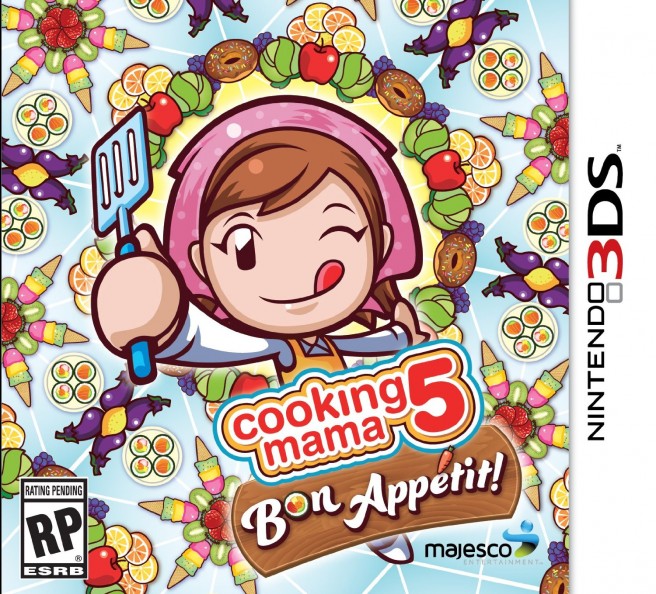Game Critics announces “Best of E3 2014” nominees
Posted on 11 years ago by Brian(@NE_Brian) in 3DS, News, Wii U | 10 Comments
Game Critics has announced its nominees for the “Best of E3 2014” awards. Nintendo picked up a few mentions, including Splatoon and Super Smash Bros.
The full list of categories can be found below. Winners will be shared on July 1.
Kirby Triple Deluxe – UK “Made For Play” commercial
Posted on 11 years ago by Brian(@NE_Brian) in 3DS, Videos | 0 comments
More: commercial, Kirby Triple Deluxe, UK
Cooking Mama 5: Bon Appétit releasing in September
Posted on 11 years ago by Brian(@NE_Brian) in 3DS, News | 0 comments
Majeso Entertainment announced a slightly more specific release window for Cooking Mama 5: Bon Appétit today. In North America and Europe, the 3DS game launches in September.
Here’s a break overview of Cooking Mama 5’s features:
Join Mama, the original kitchen diva who created the cooking genre, in Cooking Mama 5: Bon Appétit and unlock 60+ recipes to perfect a kaleidoscope of foods including appetizers, drinks, main courses, and desserts. Cook your way through classic fare, exotic cultural dishes and sweet treats including: pork cutlet rice bowl, chicken nuggets, barbeque skewers, pumpkin gratin, raisin bread, Hawaiian pancakes, gingerbread cookies, and much more! Step out of the kitchen and help Mama with more than 30 new activities around the Burger Shop and house: feed the pets, deliver orders, serve ice cream, organize crafts, even play word games!
Cooking Mama 5: Bon Appétit features intuitive stylus-based play across six modes, including the new Cooking Dojo mode where Mama slips into her gi for some serious culinary training. You can also customize your kitchen and Mama’s outfit with decorations and outfits earned through SpotPass. What’s more, single cart download play with up to three friends enables you to cook off with fellow chefs to share the experience.
Source: Majesco PR
Transformers: Rise of the Dark Spark 3DS footage
Posted on 11 years ago by Brian(@NE_Brian) in 3DS, Videos | 0 comments
Puzzle Solving Battle Tore! Treasure Hunting Adventure trailer
Posted on 11 years ago by Brian(@NE_Brian) in 3DS, Videos | 0 comments
Play the latest titles at Hyper Japan 2014 (Europe)
Posted on 11 years ago by Brian(@NE_Brian) in 3DS, News, Wii U | 0 comments
Nintendo set to showcase latest Wii U and Nintendo 3DS games at HYPER JAPAN, taking place Earls Court 25 – 27 July 2014
24th June 2014 – Nintendo will be returning to the HYPER JAPAN expo in 2014 to showcase the latest titles for Wii U and Nintendo 3DS and 2DS systems, fans can look forward to getting their hands on some of the newest Nintendo games at Earls Court Exhibition Centre, London 25 – 27 July.
As well as being able to step into the world of your favourite Nintendo franchises, with many new titles launching over the next year for Wii U and Nintendo 3DS and 2DS systems, the Nintendo stand at HYPER JAPAN 2014 will be the best place to get a first look and hands on time with a number of exclusive games. The official Nintendo UK Online Store will also be hosting a pop-up store at the event so fans can buy Nintendo merchandise and exclusive goodies while at the expo.
More: Europe, Hyper Japan 2014, press release
Another Island Days video
Posted on 11 years ago by Brian(@NE_Brian) in 3DS, Videos | 0 comments
More: Island Days, Japan, Klon
Marvelous on Story of Seasons’ name, series will continue, more
Posted on 11 years ago by Brian(@NE_Brian) in 3DS, General Nintendo, News | 1 Comment
At E3 2014, GameSpot and NintendoWorldReport spoke with Yoshifumi Hashimoto, head of development over at Marvelous AQL, to discuss Story of Seasons. Hashimoto spoke about the game’s name, the separation between the title and Harvest Moon and plans to continue the series, same-sex relationships, and more.
You can find excerpts from the interview below. Head on over to this link for the full thing.
More: marvelous, Story of Seasons, XSEED
Miyamoto talks more about unifying console and handheld development
Posted on 11 years ago by Brian(@NE_Brian) in 3DS, News, Wii U | 9 Comments
Nintendo president Satoru Iwata has previously spoken about unifying its console and handheld development. The company hasn’t said if we’ll ever see a system that embodies both types of hardware, but Nintendo wants its systems to take advantage of the same type of “architecture”.
Shigeru Miyamoto recently commented about what this may mean for the future while speaking with Kotaku. The site went a bit further and even asked if there could ever be a day in which games could be made across Nintendo devices/teams making projects that could be played on the TV/on the go.
Here’s what was shared:
